Interactive Effects of Copper Pipe, Stagnation, Corrosion Control, and Disinfectant Residual Influenced Reduction of Legionella pneumophila during Simulations of the Flint Water Crisis
Abstract
:1. Introduction
2. Materials and Methods
2.1. Source Water Treatment
2.2. Simulated Distribution Systems: Chlorination and Corrosion
2.3. General SDSs Water Preparation
2.4. Premise Plumbing
2.4.1. Simulated Premise Plumbing Reactors (SPPRs)
2.4.2. Initializing the SPPRs
2.4.3. Water Changes with SDS Conditions
2.5. Culture Confirmation
2.6. Water Quality Analyses
2.7. Data Analysis
3. Results and Discussion
3.1. Simulated Treatment and Distribution Reproduced Key Factors of Pre-, During-, and Post-Crisis Flint Water
3.1.1. Treated Source Waters Employed in this Experiment
3.1.2. SDSs Chlorine
3.1.3. SDSs Iron and Corrosion Control
3.2. Simulated Premise Plumbing Reactors Reproduced Key Water Chemistry Trends of Pre-, During, and Post-Crisis Flint Water
3.2.1. SPPRs Chlorine
3.2.2. SPPRs Copper
3.3. Legionella pneumophila Response to Simulation of Water Chemistry and Premise Plumbing Material
3.3.1. Isolate Analysis
3.3.2. Chlorine Disinfectant
3.3.3. Pipe Material: PEX and Copper
3.4. Experimental Conditions: Hypothetical Effects of Stagnation, Chlorine, and Elevated pH
4. Conclusions
Supplementary Materials
Author Contributions
Funding
Acknowledgments
Conflicts of Interest
References
- Schwake, D.O.; Garner, E.; Strom, O.R.; Pruden, A.; Edwards, M.A. Legionella DNA Markers in Tap Water Coincident with a Spike in Legionnaires’ Disease in Flint, MI. Environ. Sci. Technol. Lett. 2016, 3, 311–315. [Google Scholar] [CrossRef] [Green Version]
- Pieper, K.J.; Tang, M.; Edwards, M.A. Flint Water Crisis Caused By Interrupted Corrosion Control: Investigating “Ground Zero” Home. Environ. Sci. Technol. 2017, 51, 2007–2014. [Google Scholar] [CrossRef] [PubMed]
- Rhoads, W.J.; Garner, E.; Ji, P.; Zhu, N.; Parks, J.; Schwake, D.O.; Pruden, A.; Edwards, M.A. Distribution System Operational Deficiencies Coincide with Reported Legionnaires’ Disease Clusters in Flint, MI. Environ. Sci. Technol. 2017, 51, 11986–11995. [Google Scholar] [CrossRef] [PubMed]
- Masten, S.J.; Davies, S.H.; Mcelmurry, S.P. Flint Water Crisis: What Happened and Why? J. Awwa 2016, 108, 22–34. [Google Scholar] [CrossRef] [Green Version]
- Zahran, S.; McElmurry, S.P.; Kilgore, P.E.; Mushinski, D.; Press, J.; Love, N.G.; Sadler, R.C.; Swanson, M.S. Assessment of the Legionnaires’ disease outbreak in Flint, Michigan. Proc. Natl. Acad. Sci. USA 2018. [Google Scholar] [CrossRef] [Green Version]
- Smith, A.F.; Huss, A.; Dorevitch, S.; Heijnen, L.; Arntzen, V.H.; Davies, M.; Robert-Du Ry van Beest Holle, M.; Fujita, Y.; Verschoor, A.M.; Raterman , B.; et al. Sources of the Outbreak of Legionnaires’ Disease in Genesee County, Michigan, in 2014 and 2015. Environ. Health Perspect. 2019, 127, 127001. [Google Scholar] [CrossRef] [Green Version]
- Garrison, L.E. Vital Signs: Deficiencies in Environmental Control Identified in Outbreaks of Legionnaires’ Disease—North America, 2000–2014. Mmwr. Morb. Mortal. Wkly. Rep. 2016, 65. [Google Scholar]
- Proctor, C.R.; Dai, D.; Edwards, M.A.; Pruden, A. Interactive effects of temperature, organic carbon, and pipe material on microbiota composition and Legionella pneumophila in hot water plumbing systems. Microbiome 2017, 5, 130. [Google Scholar] [CrossRef]
- Williams, K.; Pruden, A.; Falkinham, J.O.; Edwards, M. Relationship between Organic Carbon and Opportunistic Pathogens in Simulated Glass Water Heaters. Pathogens 2015, 4, 355–372. [Google Scholar] [CrossRef] [Green Version]
- Wang, H.; Masters, S.; Falkinham, J.O.; Edwards, M.A. Distribution System Water Quality Affects Responses of Opportunistic Pathogen Gene Markers in Household Water Heaters. Environ. Sci. Technol. 2015, 49, 8416–8424. [Google Scholar] [CrossRef]
- Michigan Department of Human and Health Services (MDHHS). MDHHS Response to Flint Area Community Health and Environment Partnership Proceedings of the National Academy of Sciences Article. 2018. Available online: https://content.govdelivery.com/attachments/MIDHHS/2018/02/05/file_attachments/953946/MDHHS%2BResponse%2Bto%2BFACHEP%2BProceedings%2Bof%2Bthe%2BNational%2BAcademy%2Bof%2BSciences%2BArticle%2BFINAL.pdf (accessed on 3 September 2020).
- Martin, R.L.; Strom, O.R.; Song, Y.; Mena-Aguilar, D.; Rhoads, J.W.; Pruden, A.; Edwards, M. Copper Pipe, Lack of corrosion control, and uncontrolled pH influenced the trajectory of the Flint Legionnaires’ Disease outbreak. Environ. Sci. Technol. (under review).
- Ji, P.; Parks, J.; Edwards, M.A.; Pruden, A. Impact of Water Chemistry, Pipe Material and Stagnation on the Building Plumbing Microbiome. PLoS ONE 2015, 10, e0141087. [Google Scholar] [CrossRef] [PubMed] [Green Version]
- Lin, Y.-s.E.; Vidic, R.D.; Stout, J.E.; Victor, L.Y. Negative effect of high pH on biocidal efficacy of copper and silver ions in controlling Legionella pneumophila. Appl. Environ. Microbiol. 2002, 68, 2711–2715. [Google Scholar] [CrossRef] [PubMed] [Green Version]
- Zhang, Y.; Griffin, A.; Edwards, M. Nitrification in premise plumbing: Role of phosphate, pH and pipe corrosion. Environ. Sci. Technol. 2008, 42, 4280–4284. [Google Scholar] [CrossRef] [PubMed]
- Liu, Z.; Lin, Y.E.; Stout, J.E.; Hwang, C.C.; Vidic, R.D.; Yu, V.L. Effect of flow regimes on the presence of Legionella within the biofilm of a model plumbing system. J. Appl. Microbiol. 2006, 101, 437–442. [Google Scholar] [CrossRef] [PubMed]
- Rhoads, W.J.; Ji, P.; Pruden, A.; Edwards, M.A. Water heater temperature set point and water use patterns influence Legionella pneumophila and associated microorganisms at the tap. Microbiome 2015, 3, 1–13. [Google Scholar] [CrossRef] [Green Version]
- Shen, Y.; Guillermo, L.M.; Nicolas, D.; Dao, J. Role of Biofilm Roughness and Hydrodynamic Conditions in Legionella pneumophila Adhesion to and Detachment from Simulated Drinking Water Biofilms. Environ. Sci. Technol. 2015, 49, 4274. [Google Scholar] [CrossRef] [Green Version]
- Mathys, W.; Stanke, J.; Harmuth, M.; Junge-Mathys, E. Occurrence of Legionella in hot water systems of single-family residences in suburbs of two German cities with special reference to solar and district heating. Int. J. Hyg. Environ. Health 2008, 211, 179–185. [Google Scholar] [CrossRef]
- Rhoads, W.; Pruden, A.; Edwards, M. Convective Mixing in Distal Pipes Exacerbates Legionella pneumophila Growth in Hot Water Plumbing. Pathogens 2016, 5, 29. [Google Scholar] [CrossRef] [Green Version]
- Mouchtouri, V.A.; Goutziana, G.; Kremastinou, J.; Hadjichristodoulou, C. Legionella species colonization in cooling towers: Risk factors and assessment of control measures. Am. J. Infect. Control 2010, 38, 50–55. [Google Scholar] [CrossRef]
- Kim, B.R.; Anderson, J.E.; Mueller, S.A.; Gaines, W.A.; Kendall, A.M. Literature review—efficacy of various disinfectants against Legionella in water systems. Water Res. 2002, 36, 4433–4444. [Google Scholar] [CrossRef]
- Muraca, P.; Stout, J.E.; Yu, V.L. Comparative assessment of chlorine, heat, ozone, and UV light for killing Legionella pneumophila within a model plumbing system. Appl. Environ. Microbiol. 1987, 53, 447–453. [Google Scholar] [CrossRef] [PubMed] [Green Version]
- Nguyen, C.; Elfland, C.; Edwards, M. Impact of advanced water conservation features and new copper pipe on rapid chloramine decay and microbial regrowth. Water Res. 2012, 46, 611–621. [Google Scholar] [CrossRef] [PubMed]
- Nguyen, C.K.; Powers, K.A.; Raetz, M.A.; Parks, J.L.; Edwards, M.A. Rapid free chlorine decay in the presence of Cu(OH)2: Chemistry and practical implications. Water Res. 2011, 45, 5302–5312. [Google Scholar] [CrossRef] [PubMed]
- Zheng, M.; He, C.; He, Q. Fate of free chlorine in drinking water during distribution in premise plumbing. Ecotoxicology 2015, 24, 2151–2155. [Google Scholar] [CrossRef] [PubMed]
- Dai, D.; Proctor, C.R.; Williams, K.; Edwards, M.A.; Pruden, A. Mediation of effects of biofiltration on bacterial regrowth, Legionella pneumophila, and the microbial community structure under hot water plumbing conditions. Environ. Sci. Water Res. Technol. 2018, 4, 183–194. [Google Scholar] [CrossRef]
- Merault, N.; Rusniok, C.; Jarraud, S.; Gomez-Valero, L.; Cazalet, C.; Marin, M.; Brachet, E.; Aegerter, P.; Gaillard, J.; Etienne, J. Specific real-time PCR for simultaneous detection and identification of Legionella pneumophila serogroup 1 in water and clinical samples. Appl. Environ. Microbiol. 2011, 77, 1708–1717. [Google Scholar] [CrossRef] [Green Version]
- Kozak, N.A.; Benson, R.F.; Brown, E.; Alexander, N.T.; Taylor, T.H.; Shelton, B.G.; Fields, B.S. Distribution of lag-1 alleles and sequence-based types among Legionella pneumophila serogroup 1 clinical and environmental isolates in the United States. J. Clin. Microbiol. 2009, 47, 2525–2535. [Google Scholar] [CrossRef] [Green Version]
- Flint Water Treatment Plant. Monthly Operating Reports. Available online: https://www.michigan.gov/flintwater/0,6092,7-345-76292_76364-377816--,00.html (accessed on 28 January 2020).
- Miller, C.M.; Bower, K.C. Iron Oxide Enhanced Chlorine Decay and Disinfection By-Product Formation. J. Environ. Eng. 2006, 132, 1609–1616. [Google Scholar] [CrossRef]
- McNeill, L.S.; Edwards, M. Iron pipe corrosion in distribution systems. J. Am. Water Work. Assoc. 2001, 93, 88–100. [Google Scholar] [CrossRef]
- McNeill, L.S.; Edwards, M. Phosphate inhibitor use at US utilities. J. Am. Water Work. Assoc. 2002, 94, 57–63. [Google Scholar] [CrossRef]
- Wahman, D.G.; Pressman, J.G. Distribution System Residuals—Is “Detectable” Still Acceptable for Chloramines? J. Awwa 2015, 107, 53–63. [Google Scholar] [CrossRef]
- National Academies of Sciences and Engineering. Management of Legionella in Water Systems; The National Academies Press: Washington, DC, USA, 2019. [Google Scholar] [CrossRef]
- Lin, Y.E.; Vidic, R.D. Possible phosphate interference with copper–silver ionization for Legionella control. J. Hosp. Infect. 2006, 62, 119. [Google Scholar] [CrossRef] [PubMed]
- Orsi, G.B.; Vitali, M.; Marinelli, L.; Ciorba, V.; Tufi, D.; Del Cimmuto, A.; Ursillo, P.; Fabiani, M.; De Santis, S.; Protano, C.; et al. Legionella control in the water system of antiquated hospital buildings by shock and continuous hyperchlorination: 5 years experience. Bmc Infect. Dis. 2014, 14, 394. [Google Scholar] [CrossRef] [PubMed] [Green Version]
- Alary, M.; Joly, J.R. Factors contributing to the contamination of hospital water distribution systems by Legionellae. J. Infect. Dis. 1992, 165, 565–569. [Google Scholar] [CrossRef] [PubMed]
- Rhoads, W.J.; Pruden, A.; Edwards, M.A. Interactive Effects of Corrosion, Copper, and Chloramines on Legionella and Mycobacteria in Hot Water Plumbing. Environ. Sci. Technol. 2017. [Google Scholar] [CrossRef]
- Triantafyllidou, S.; Lytle, D.; Muhlen, C.; Swertfeger, J. Copper-silver ionization at a US hospital: Interaction of treated drinking water with plumbing materials, aesthetics and other considerations. Water Res. 2016, 102, 1–10. [Google Scholar] [CrossRef] [Green Version]
- Lin, Y.E.; Stout, J.E.; Vidic, R.D. Disinfection of water distribution systems for Legionella. Semin. Respir. Infect. 1998, 13, 147–159. [Google Scholar]
- Van der Kooij, D.; Veenendaal, H.R.; Scheffer, W.J.H. Biofilm formation and multiplication of Legionella in a model warm water system with pipes of copper, stainless steel and cross-linked polyethylene. Water Res. 2005, 39, 2789–2798. [Google Scholar] [CrossRef]
- Gião, M.S.; Wilks, S.A.; Keevil, C.W. Influence of copper surfaces on biofilm formation by Legionella pneumophila in potable water. Biometals 2015, 28, 329. [Google Scholar] [CrossRef]
- Falkinham, J.O.; Pruden, A.; Edwards, M. Opportunistic Premise Plumbing Pathogens: Increasingly Important Pathogens in Drinking Water. Pathogens 2015, 4, 373–386. [Google Scholar] [CrossRef] [PubMed] [Green Version]
- Lau, H.; Ashbolt, N. The role of biofilms and protozoa in Legionella pathogenesis: Implications for drinking water. J. Appl. Microbiol. 2009, 107, 368–378. [Google Scholar] [CrossRef] [PubMed]
- Buse, H.Y.; Lu, J.; Struewing, I.T.; Ashbolt, N.J. Preferential colonization and release of Legionella pneumophila from mature drinking water biofilms grown on copper versus unplasticized polyvinylchloride coupons. Int. J. Hyg. Environ. Health 2014, 217, 219. [Google Scholar] [CrossRef] [PubMed]
- Bédard, E.; Paranjape, K.; Lalancette, C.; Villion, M.; Quach, C.; Laferrière, C.; Faucher, S.P.; Prévost, M. Legionella pneumophila levels and sequence-type distribution in hospital hot water samples from faucets to connecting pipes. Water Res. 2019, 156, 277–286. [Google Scholar] [CrossRef] [PubMed]
- Moore, M.R.; Pryor, M.; Fields, B.; Lucas, C.; Phelan, M.; Besser, R.E. Introduction of monochloramine into a municipal water system: Impact on colonization of buildings by Legionella spp. Appl. Environ. Microbiol. 2006, 72, 378–383. [Google Scholar] [CrossRef] [Green Version]
- Donohue, M.J.; O’Connell, K.; Vesper, S.J.; Mistry, J.H.; King, D.; Kostich, M.; Pfaller, S. Widespread Molecular Detection of Legionella pneumophila Serogroup 1 in Cold Water Taps across the United States. Environ. Sci. Technol. 2014, 48, 3145–3152. [Google Scholar] [CrossRef]
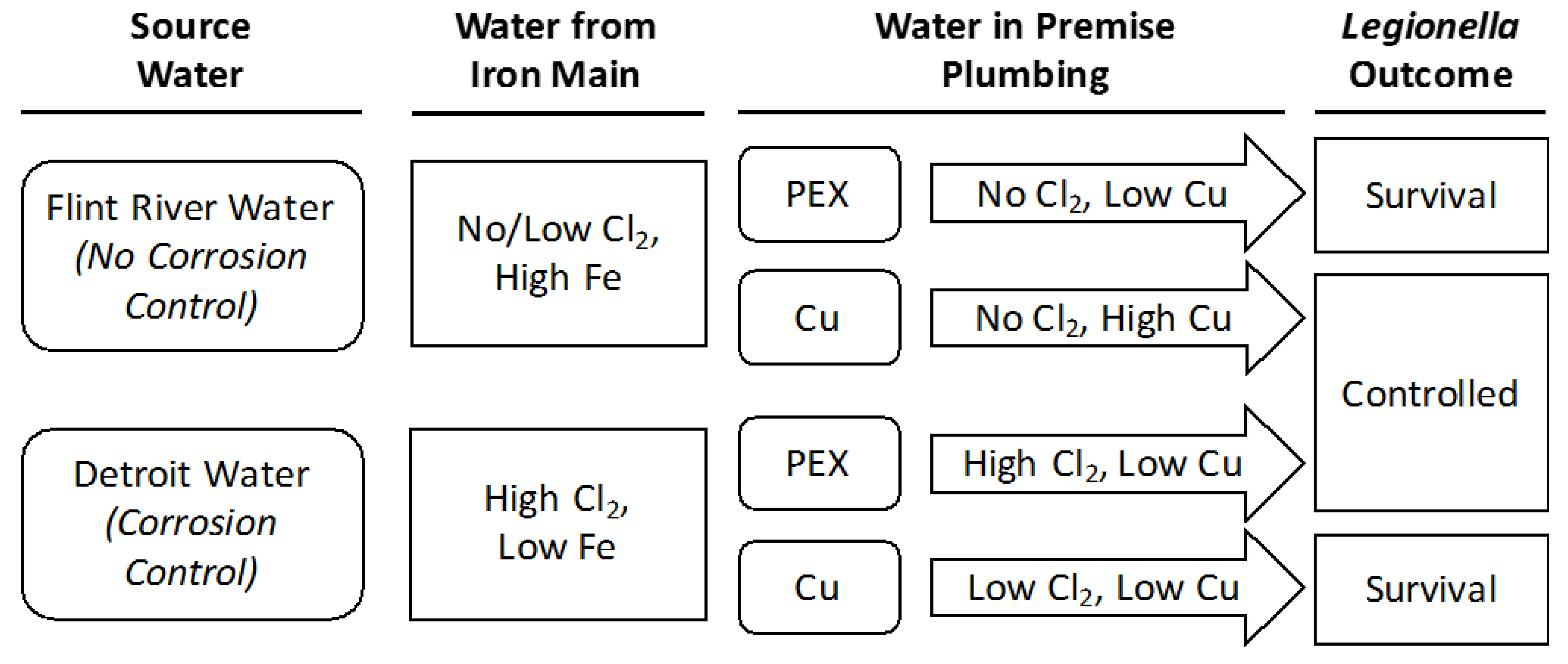
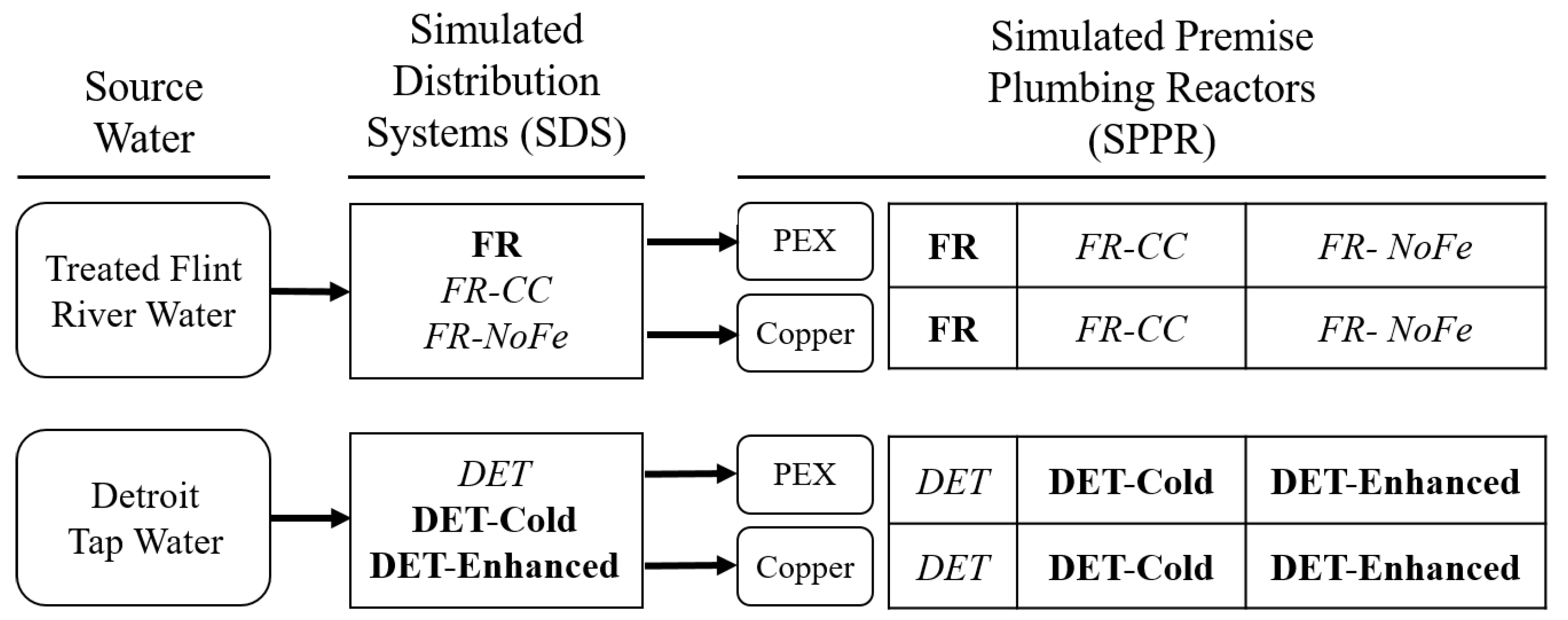
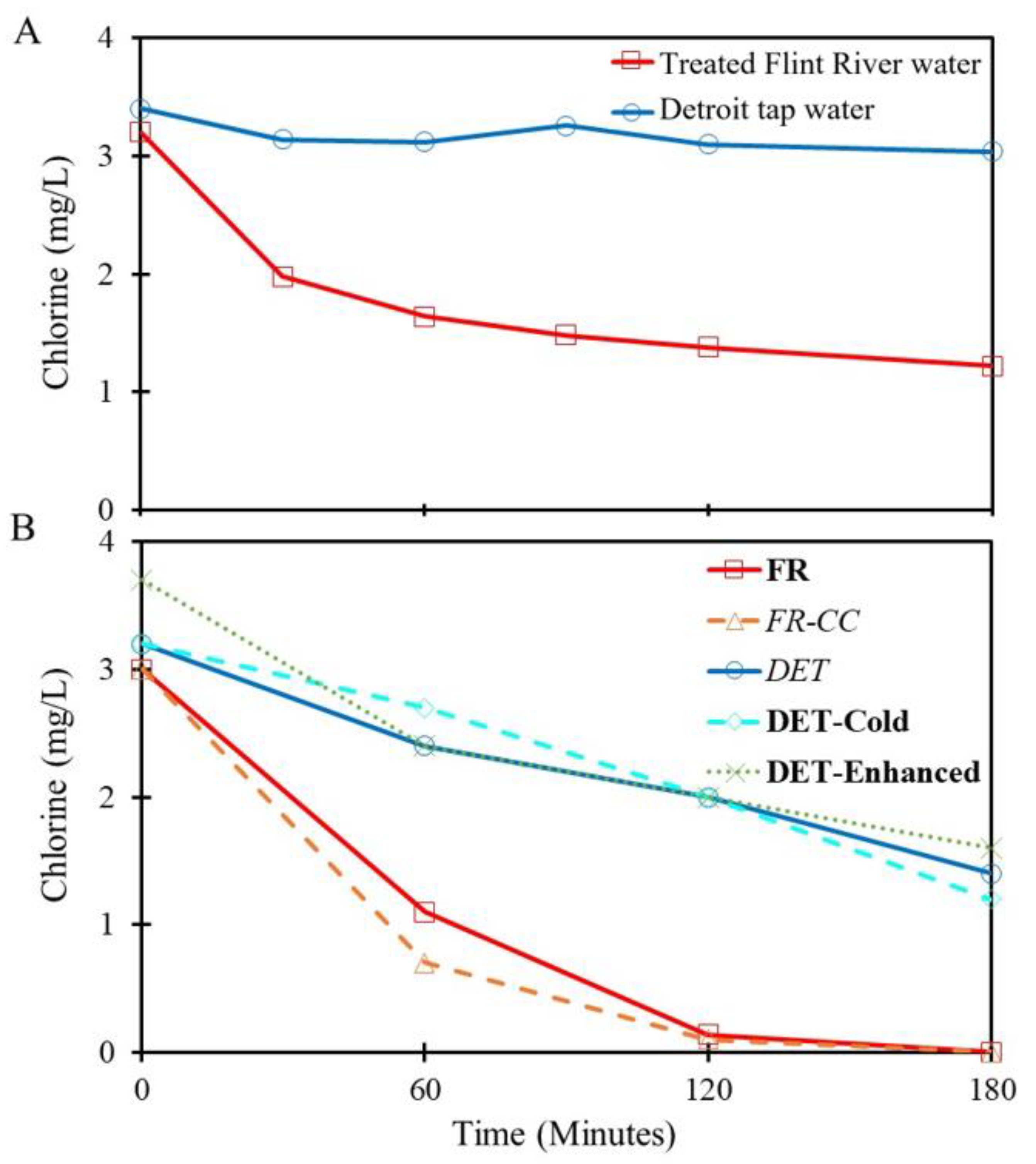

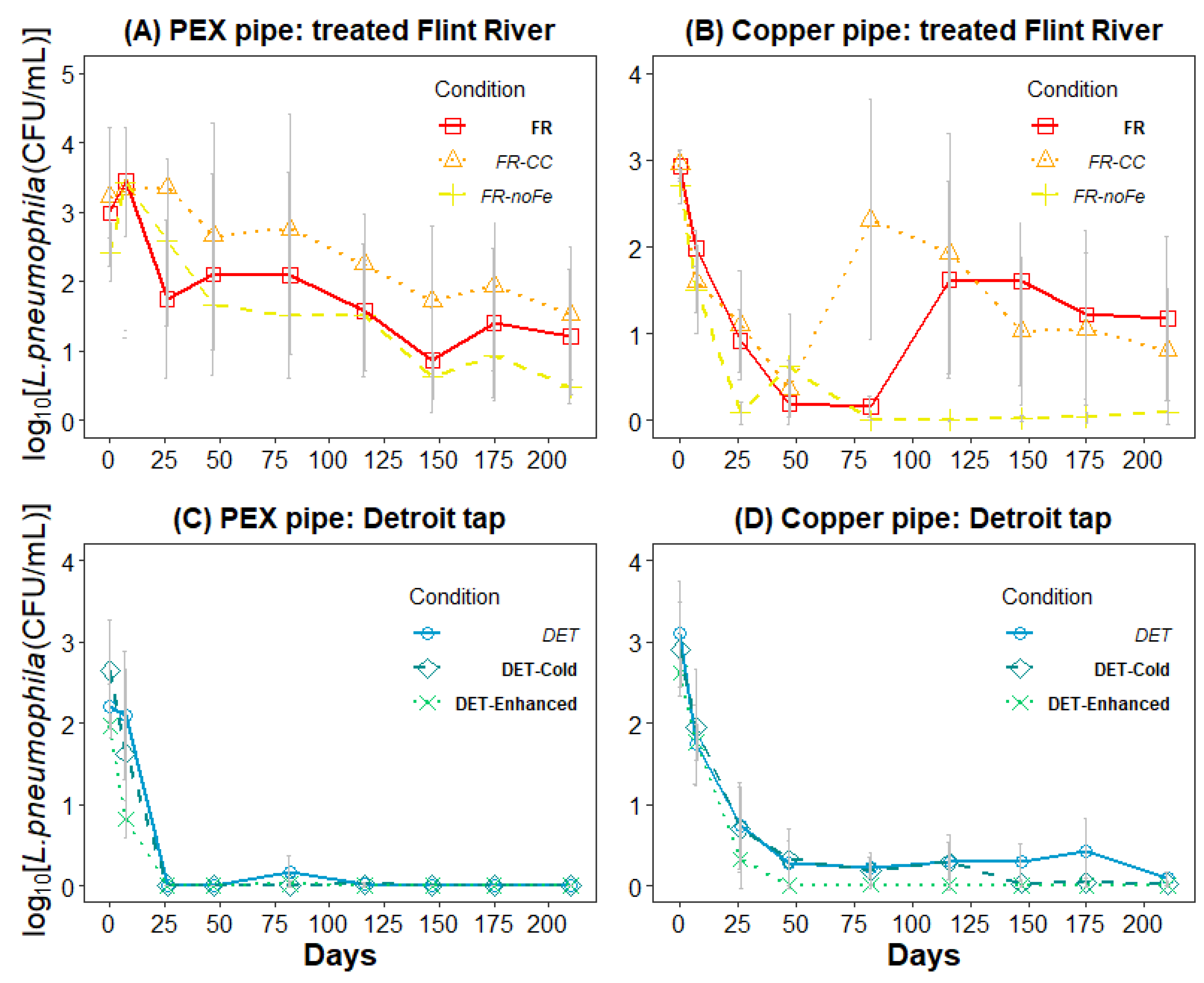
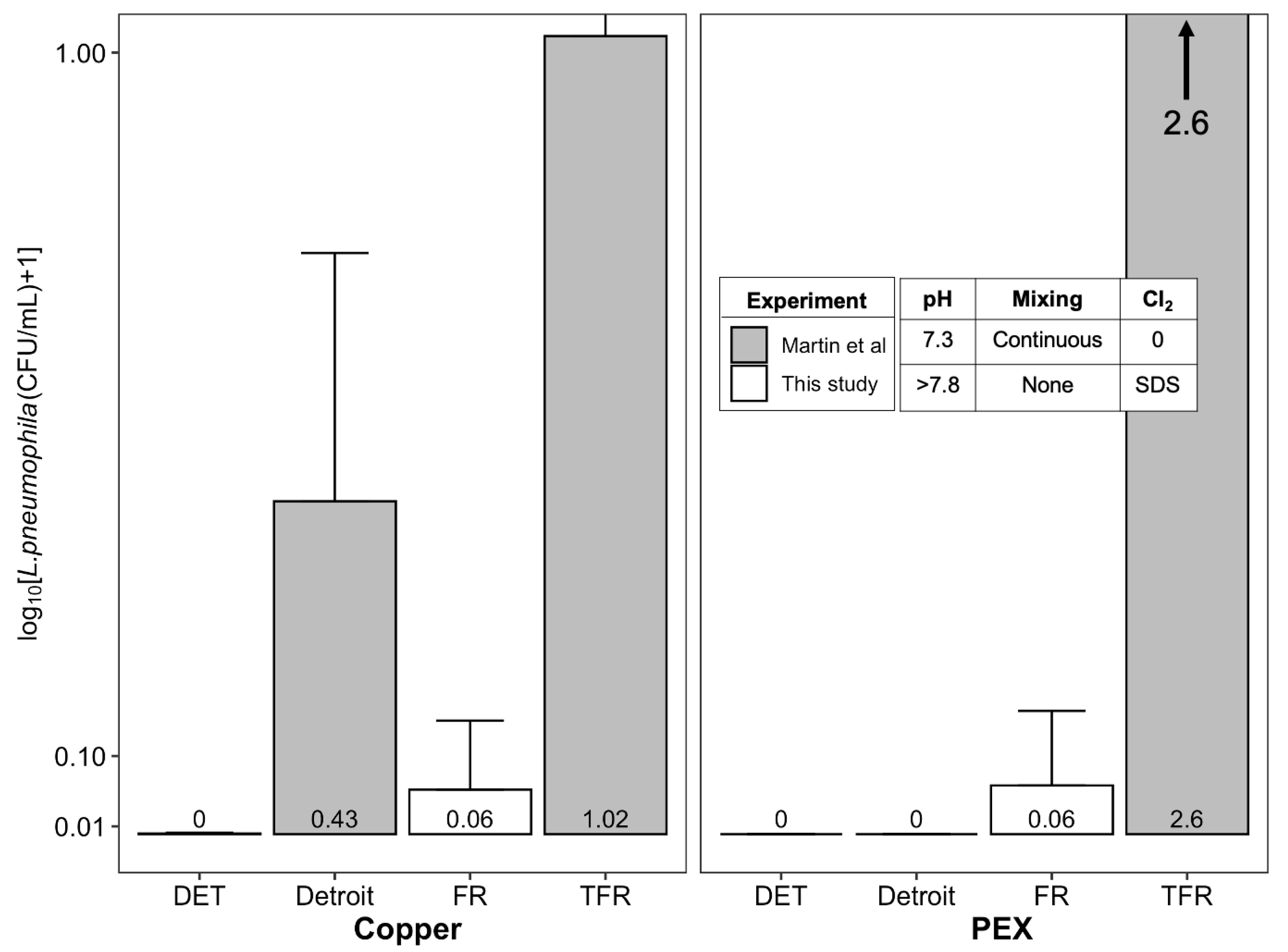
| A: Flint Water Crisis Field Data * | B: Simulated Distribution System Influent ^ | C: Simulated Distribution System (T, Cl2, Fe) or Simulated Premise Plumbing Reactor (Cu) Effluent + | |||||||||||||
|---|---|---|---|---|---|---|---|---|---|---|---|---|---|---|---|
| Condition | Pre-Crisis | Crisis | Post-Crisis | DET-Cold | FR | DET-Enhanced | FR-CC | FR-NoFe | DET | DET-Cold | FR | DET-Enhanced | FR-CC | FR-NoFe | DET |
| Temp (°C) | 20 ± 2.2 | 23 ± 2.1 | 18 ± 2.4 | 18 | 22 | 22 | 22 | 22 | 22 | 18 ± 1.4 | 22 ± 1.3 | 22 ± 1.3 | 22 ± 1.3 | 22 ± 1.3 | 22 ± 1.3 |
| Chlorine (mg/L Cl2) | 0.50 ± 0.19 | 0.28 ± 0.24 | 0.38 ± 0.16 | 3.10 ± 0.20 | 3.10 ± 0.21 | 3.80 ± 0.19 | 3.10 ± 0.21 | 3.10 ± 0.21 | 3.10 ± 0.20 | 1.28 ± 0.23 | 0.26 ± 0.23 | 1.87 ± 0.70 | 0.17 ± 0.20 | 1.27 ± 0.49 | 1.07 ± 0.52 |
| Flushed Total Iron (μg/L) | UNK | 208 (21–340) | 42.4 (0–130) | 92.1 (80–110) | 15.4 (2.0–47) | 92.1 (80–110) | 15.4 (2.0–47) | 15.4 (2.0–47) | 92.1 (80–110) | 1300 (490–2500) | 2300 (590–5200) | 900 (360– 2000) | 3100 (690–9500) | 15.4 (2.0–47) | 2400 (710–6000) |
| Total Copper (μg/L) | UNK | 129 (14–380) | 46 (3.0–140) | 12 (5.7–20) | 8.0 (4.1–15) | 8.0 (5.7–20) | 8.0 (4.1–15) | 8.0 (4.1–15) | 12 (5.7–20) | 962 (510–1390) | 2380 (1790–3120) | 510 (170– 1100) | 1200 (520–2000) | 650 (530–850) | 880 (640–1400) |
© 2020 by the authors. Licensee MDPI, Basel, Switzerland. This article is an open access article distributed under the terms and conditions of the Creative Commons Attribution (CC BY) license (http://creativecommons.org/licenses/by/4.0/).
Share and Cite
Martin, R.L.; Strom, O.R.; Pruden, A.; Edwards, M.A. Interactive Effects of Copper Pipe, Stagnation, Corrosion Control, and Disinfectant Residual Influenced Reduction of Legionella pneumophila during Simulations of the Flint Water Crisis. Pathogens 2020, 9, 730. https://doi.org/10.3390/pathogens9090730
Martin RL, Strom OR, Pruden A, Edwards MA. Interactive Effects of Copper Pipe, Stagnation, Corrosion Control, and Disinfectant Residual Influenced Reduction of Legionella pneumophila during Simulations of the Flint Water Crisis. Pathogens. 2020; 9(9):730. https://doi.org/10.3390/pathogens9090730
Chicago/Turabian StyleMartin, Rebekah L., Owen R. Strom, Amy Pruden, and Marc A. Edwards. 2020. "Interactive Effects of Copper Pipe, Stagnation, Corrosion Control, and Disinfectant Residual Influenced Reduction of Legionella pneumophila during Simulations of the Flint Water Crisis" Pathogens 9, no. 9: 730. https://doi.org/10.3390/pathogens9090730
APA StyleMartin, R. L., Strom, O. R., Pruden, A., & Edwards, M. A. (2020). Interactive Effects of Copper Pipe, Stagnation, Corrosion Control, and Disinfectant Residual Influenced Reduction of Legionella pneumophila during Simulations of the Flint Water Crisis. Pathogens, 9(9), 730. https://doi.org/10.3390/pathogens9090730





